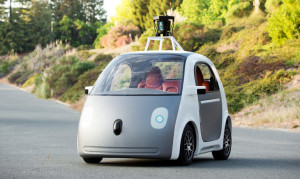
Driverless cars, like the one Google launched in 2012, are touted for their potential energy savings, but engineers say we should consider the possibility that the technology will intensify car use.
If people can work, relax, and even hold meetings in their cars, they may drive more.
That has the potential to erode the energy and environmental benefits of self-driving cars, according to a new study published in the journal Transportation Research Part A.
“There is a lot of hype around self-driving cars, much of it somewhat utopian in nature. But there are likely to be positives and negatives,” says study coauthor Don MacKenzie, an assistant professor of civil and environmental engineering at the University of Washington. “By taking a clear-eyed view, we can design and implement policies to maximize the benefits and minimize the downsides of automated vehicles.”
U.S. ROADS BY 2050
The study analyzes self-driving technology combined with data on car and truck use, driver licenses, and vehicle running costs to model the impact on energy demand of various levels of automation on US roads by 2050.
The analysis identifies several efficiency benefits from self-driving cars and predicts ranges of likely energy impacts, depending on the extent of adoption of the technology and other factors:
- More efficient computer-directed driving styles (0 to 20 percent reduction in energy use)
- Improved traffic flow and reduced jams because of coordination between vehicles (0 to 4 percent reduction)
- “Platooning” of automated vehicles driving very close together to create aerodynamic savings (4 to 25 percent reduction)
- Reduced crash risks mean that cars can be lighter (5 to 23 percent reduction)
- Less emphasis from car buyers on high performance (5 to 23 percent reduction)
But the study also predicts that the very attractiveness of self-driving technology could reduce or even outweigh the efficiency gains.
It estimates a 5 to 60 percent increase in car energy consumption due to people choosing to use highly automated cars in situations where they would have previously taken alternative transport (e.g., trains or planes).
“When you make a decision about transport, you don’t just think about the out-of-pocket costs of the train ticket or the car’s petrol; you also take into account non-financial costs,” says lead author Zia Wadud, an associate professor at the University of Leeds.
“Car owners might choose to travel by train to relatively distant business meetings because the train allows them to work and relax. The need to drive is part of the cost of choosing the car, just as standing on a cold platform is part of the cost of the train.
“If you can relax in your car as it safely drives itself to a meeting in another city, that changes the whole equation,” Wadud says.
MORE PEOPLE, FASTER SPEEDS
The study also predicts that people who currently find it difficult or impossible to drive, such as the elderly or some people with disabilities, will have increased access to road transport with the advent of the new systems, resulting in an estimated 2 to 10 percent increase in road energy use for personal travel.
Possible higher speed limits because of the improved safety of autonomous cars (7 to 22 percent) and demand for heavy extra equipment in driverless cars such as TV screens and computers (0 to 11 percent) might also tend to reduce efficiency savings.
A major uncertainty is the effect of autonomous driving technology on car-sharing. The technology could allow vehicles to move independently between different users and therefore not only increase sharing, but possibly also make it easier for users to match trip types to car types.
Instead of using one car for all journeys, users might be able to use a shared, smaller car for a commute and a larger one for family leisure trips, for example. The authors say these factors could reduce energy consumption by 21 to 45 percent.
The study says many of the energy benefits of self-driving technology could be delivered by systems that still require the human driver to pay attention to the road and therefore do not radically alter transport decision-making.
POLICIES LIKE ‘ROAD PRICING’
The authors suggest that policymakers could focus less on accelerating the introduction of complete automation and more on promoting aspects of automation with positive environmental outcomes. For instance, regulators could encourage standardization of car networking protocols to allow vehicles to communicate with each other on the road and therefore deliver benefits such as “platooning.”
The researchers warn that, if a high level of automation becomes the norm, it may be necessary to financially intervene in transport decisions. For example, self-driving cars’ navigation and communication systems could be used as a basis for road pricing schemes to control congestion and reduce overall travel demand.
“Vehicle automation presents a paradox: it may encourage people to travel much more, but at the same time it makes it practical to implement tools such as road pricing that can offset those effects,” MacKenzie says. “Ultimately, however, it’s up to government to set appropriate policies to manage these impacts.”
Paul Leiby, a research scientist at Oak Ridge National Laboratory, is a study coauthor.
Source: University of Washington and Futurity.org




